Management Accounting Report: Inventory and Budgeting for Smart Looks
VerifiedAdded on 2020/02/12
|24
|5145
|60
Report
AI Summary
This management accounting report analyzes the case of Smart Looks, a clothing retailer, covering various aspects of cost accounting and budgeting. The report begins by classifying costs (fixed, variable, semi-variable) and explores different cost classification methods. It then delves into inventory valuation using FIFO, LIFO, and average cost methods, calculating cost of goods sold under each method. The report also includes total and unit cost calculations at different production levels, with graphical presentations. Furthermore, it evaluates critical success factors and their associated performance indicators, along with strategies for cost reduction and quality enhancement. The report then examines budgeting techniques, including sales, production, raw materials, labor, and overhead budgets, culminating in the preparation of a cash budget. Finally, it addresses variance analysis, calculating budgeted and actual profit, and providing recommendations for improvement.

Management Accounting
Paraphrase This Document
Need a fresh take? Get an instant paraphrase of this document with our AI Paraphraser
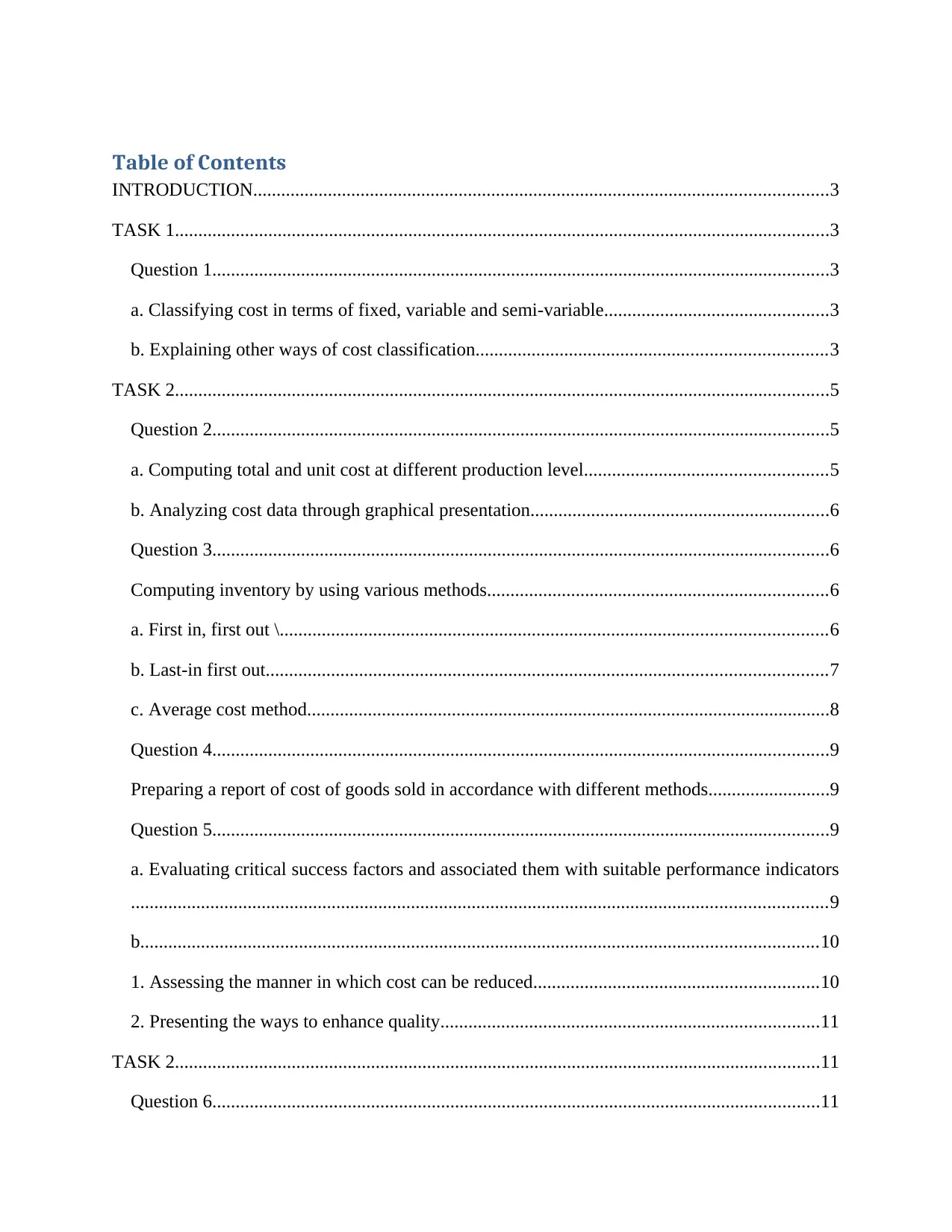
Table of Contents
INTRODUCTION...........................................................................................................................3
TASK 1............................................................................................................................................3
Question 1....................................................................................................................................3
a. Classifying cost in terms of fixed, variable and semi-variable................................................3
b. Explaining other ways of cost classification...........................................................................3
TASK 2............................................................................................................................................5
Question 2....................................................................................................................................5
a. Computing total and unit cost at different production level....................................................5
b. Analyzing cost data through graphical presentation................................................................6
Question 3....................................................................................................................................6
Computing inventory by using various methods.........................................................................6
a. First in, first out \.....................................................................................................................6
b. Last-in first out........................................................................................................................7
c. Average cost method................................................................................................................8
Question 4....................................................................................................................................9
Preparing a report of cost of goods sold in accordance with different methods..........................9
Question 5....................................................................................................................................9
a. Evaluating critical success factors and associated them with suitable performance indicators
.....................................................................................................................................................9
b.................................................................................................................................................10
1. Assessing the manner in which cost can be reduced.............................................................10
2. Presenting the ways to enhance quality.................................................................................11
TASK 2..........................................................................................................................................11
Question 6..................................................................................................................................11
INTRODUCTION...........................................................................................................................3
TASK 1............................................................................................................................................3
Question 1....................................................................................................................................3
a. Classifying cost in terms of fixed, variable and semi-variable................................................3
b. Explaining other ways of cost classification...........................................................................3
TASK 2............................................................................................................................................5
Question 2....................................................................................................................................5
a. Computing total and unit cost at different production level....................................................5
b. Analyzing cost data through graphical presentation................................................................6
Question 3....................................................................................................................................6
Computing inventory by using various methods.........................................................................6
a. First in, first out \.....................................................................................................................6
b. Last-in first out........................................................................................................................7
c. Average cost method................................................................................................................8
Question 4....................................................................................................................................9
Preparing a report of cost of goods sold in accordance with different methods..........................9
Question 5....................................................................................................................................9
a. Evaluating critical success factors and associated them with suitable performance indicators
.....................................................................................................................................................9
b.................................................................................................................................................10
1. Assessing the manner in which cost can be reduced.............................................................10
2. Presenting the ways to enhance quality.................................................................................11
TASK 2..........................................................................................................................................11
Question 6..................................................................................................................................11

a. Definition of budget...............................................................................................................11
b. Purpose of budgets.................................................................................................................12
c. Assessing the different methods of budget preparation and suggesting the most suitable one
for Smart looks..........................................................................................................................12
Question7...................................................................................................................................14
a. Sales budget...........................................................................................................................14
b. Production budget..................................................................................................................14
c. Raw material budgets.............................................................................................................14
d. Labor budgets........................................................................................................................15
e. Total overhead budget............................................................................................................15
Question 8..................................................................................................................................16
Preparing cash budget for Smart Looks for the year ended at 30th June 2017...........................16
TASK 3..........................................................................................................................................17
Question 9..................................................................................................................................17
a. Calculating budgeted profit for March 2017.........................................................................17
b. Computation of actual profit..................................................................................................17
c. Calculating material and labor sub-variances........................................................................17
d. Preparing an operating statement reconciled budget and actual profit..................................18
Question 10................................................................................................................................18
Explaining reason behind the deviations and giving recommendations for improvement........18
CONCLUSION..............................................................................................................................19
REFERENCES..............................................................................................................................21
b. Purpose of budgets.................................................................................................................12
c. Assessing the different methods of budget preparation and suggesting the most suitable one
for Smart looks..........................................................................................................................12
Question7...................................................................................................................................14
a. Sales budget...........................................................................................................................14
b. Production budget..................................................................................................................14
c. Raw material budgets.............................................................................................................14
d. Labor budgets........................................................................................................................15
e. Total overhead budget............................................................................................................15
Question 8..................................................................................................................................16
Preparing cash budget for Smart Looks for the year ended at 30th June 2017...........................16
TASK 3..........................................................................................................................................17
Question 9..................................................................................................................................17
a. Calculating budgeted profit for March 2017.........................................................................17
b. Computation of actual profit..................................................................................................17
c. Calculating material and labor sub-variances........................................................................17
d. Preparing an operating statement reconciled budget and actual profit..................................18
Question 10................................................................................................................................18
Explaining reason behind the deviations and giving recommendations for improvement........18
CONCLUSION..............................................................................................................................19
REFERENCES..............................................................................................................................21
⊘ This is a preview!⊘
Do you want full access?
Subscribe today to unlock all pages.

Trusted by 1+ million students worldwide
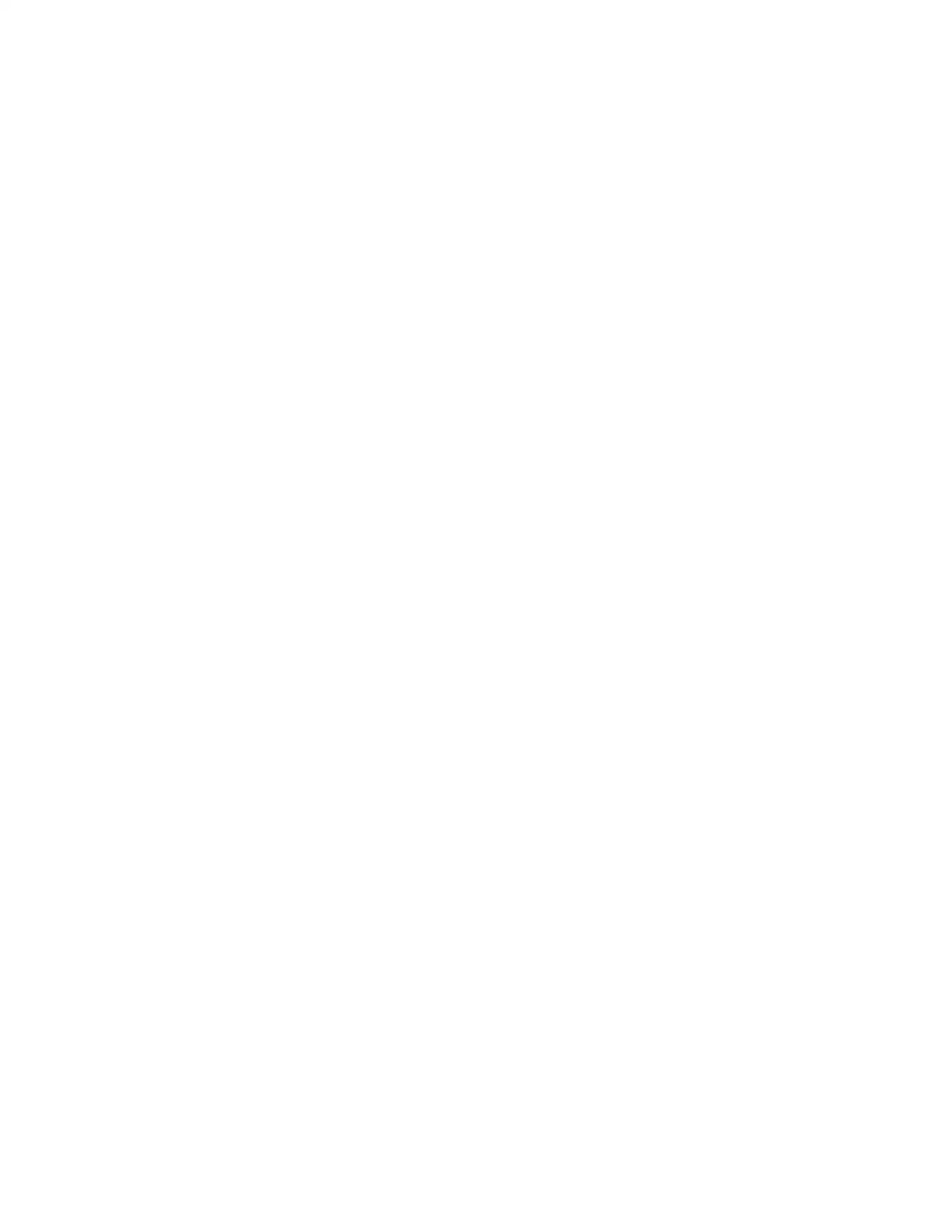
Paraphrase This Document
Need a fresh take? Get an instant paraphrase of this document with our AI Paraphraser
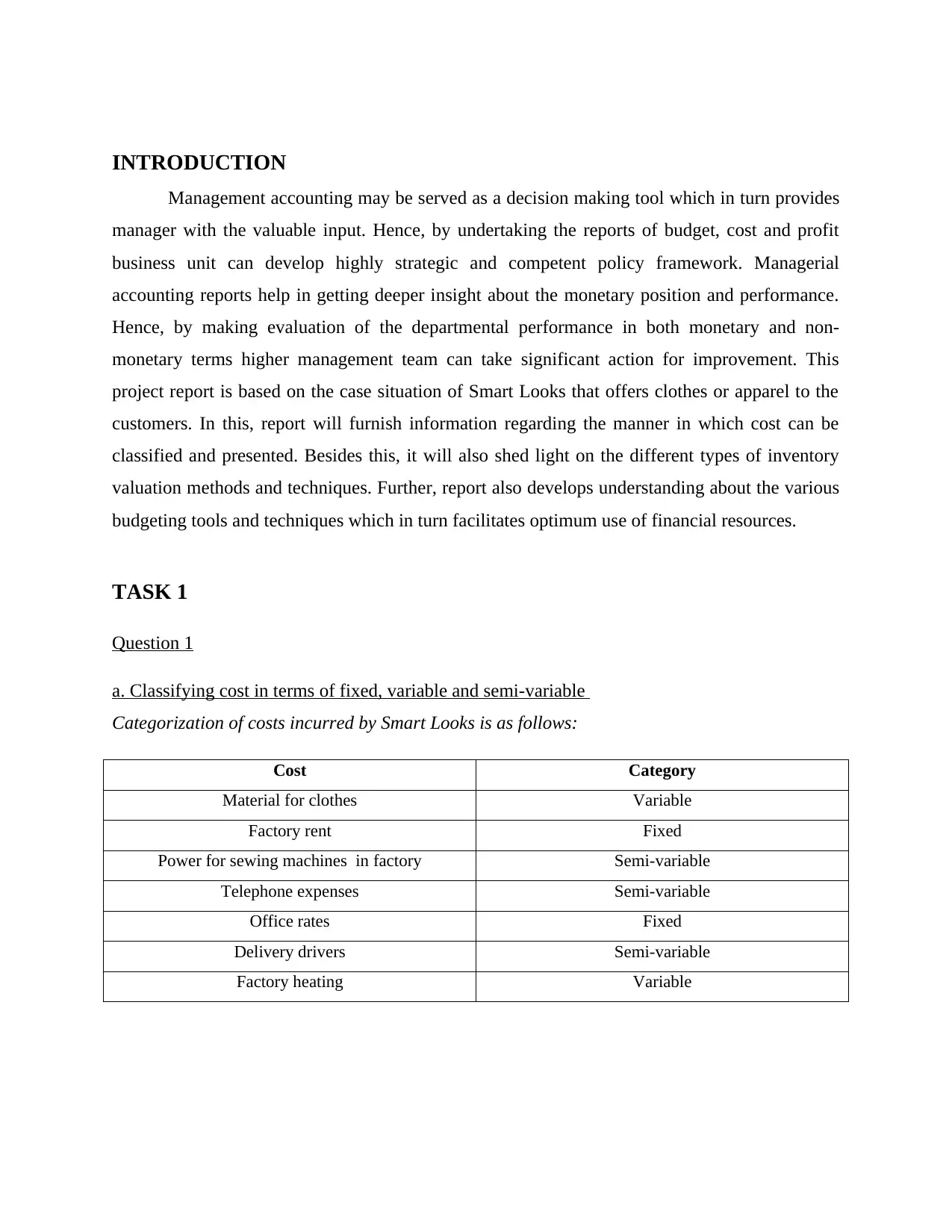
INTRODUCTION
Management accounting may be served as a decision making tool which in turn provides
manager with the valuable input. Hence, by undertaking the reports of budget, cost and profit
business unit can develop highly strategic and competent policy framework. Managerial
accounting reports help in getting deeper insight about the monetary position and performance.
Hence, by making evaluation of the departmental performance in both monetary and non-
monetary terms higher management team can take significant action for improvement. This
project report is based on the case situation of Smart Looks that offers clothes or apparel to the
customers. In this, report will furnish information regarding the manner in which cost can be
classified and presented. Besides this, it will also shed light on the different types of inventory
valuation methods and techniques. Further, report also develops understanding about the various
budgeting tools and techniques which in turn facilitates optimum use of financial resources.
TASK 1
Question 1
a. Classifying cost in terms of fixed, variable and semi-variable
Categorization of costs incurred by Smart Looks is as follows:
Cost Category
Material for clothes Variable
Factory rent Fixed
Power for sewing machines in factory Semi-variable
Telephone expenses Semi-variable
Office rates Fixed
Delivery drivers Semi-variable
Factory heating Variable
Management accounting may be served as a decision making tool which in turn provides
manager with the valuable input. Hence, by undertaking the reports of budget, cost and profit
business unit can develop highly strategic and competent policy framework. Managerial
accounting reports help in getting deeper insight about the monetary position and performance.
Hence, by making evaluation of the departmental performance in both monetary and non-
monetary terms higher management team can take significant action for improvement. This
project report is based on the case situation of Smart Looks that offers clothes or apparel to the
customers. In this, report will furnish information regarding the manner in which cost can be
classified and presented. Besides this, it will also shed light on the different types of inventory
valuation methods and techniques. Further, report also develops understanding about the various
budgeting tools and techniques which in turn facilitates optimum use of financial resources.
TASK 1
Question 1
a. Classifying cost in terms of fixed, variable and semi-variable
Categorization of costs incurred by Smart Looks is as follows:
Cost Category
Material for clothes Variable
Factory rent Fixed
Power for sewing machines in factory Semi-variable
Telephone expenses Semi-variable
Office rates Fixed
Delivery drivers Semi-variable
Factory heating Variable
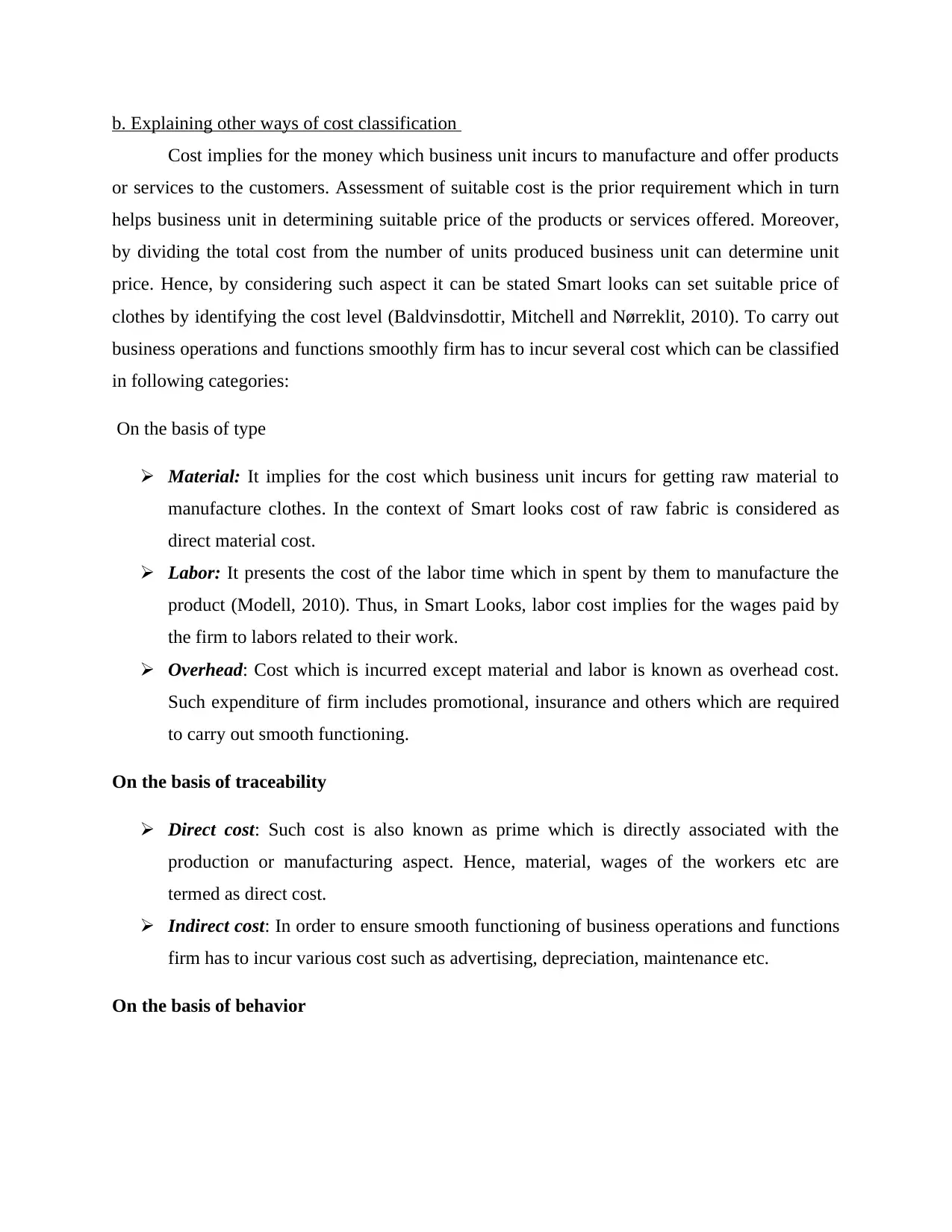
b. Explaining other ways of cost classification
Cost implies for the money which business unit incurs to manufacture and offer products
or services to the customers. Assessment of suitable cost is the prior requirement which in turn
helps business unit in determining suitable price of the products or services offered. Moreover,
by dividing the total cost from the number of units produced business unit can determine unit
price. Hence, by considering such aspect it can be stated Smart looks can set suitable price of
clothes by identifying the cost level (Baldvinsdottir, Mitchell and Nørreklit, 2010). To carry out
business operations and functions smoothly firm has to incur several cost which can be classified
in following categories:
On the basis of type
Material: It implies for the cost which business unit incurs for getting raw material to
manufacture clothes. In the context of Smart looks cost of raw fabric is considered as
direct material cost.
Labor: It presents the cost of the labor time which in spent by them to manufacture the
product (Modell, 2010). Thus, in Smart Looks, labor cost implies for the wages paid by
the firm to labors related to their work.
Overhead: Cost which is incurred except material and labor is known as overhead cost.
Such expenditure of firm includes promotional, insurance and others which are required
to carry out smooth functioning.
On the basis of traceability
Direct cost: Such cost is also known as prime which is directly associated with the
production or manufacturing aspect. Hence, material, wages of the workers etc are
termed as direct cost.
Indirect cost: In order to ensure smooth functioning of business operations and functions
firm has to incur various cost such as advertising, depreciation, maintenance etc.
On the basis of behavior
Cost implies for the money which business unit incurs to manufacture and offer products
or services to the customers. Assessment of suitable cost is the prior requirement which in turn
helps business unit in determining suitable price of the products or services offered. Moreover,
by dividing the total cost from the number of units produced business unit can determine unit
price. Hence, by considering such aspect it can be stated Smart looks can set suitable price of
clothes by identifying the cost level (Baldvinsdottir, Mitchell and Nørreklit, 2010). To carry out
business operations and functions smoothly firm has to incur several cost which can be classified
in following categories:
On the basis of type
Material: It implies for the cost which business unit incurs for getting raw material to
manufacture clothes. In the context of Smart looks cost of raw fabric is considered as
direct material cost.
Labor: It presents the cost of the labor time which in spent by them to manufacture the
product (Modell, 2010). Thus, in Smart Looks, labor cost implies for the wages paid by
the firm to labors related to their work.
Overhead: Cost which is incurred except material and labor is known as overhead cost.
Such expenditure of firm includes promotional, insurance and others which are required
to carry out smooth functioning.
On the basis of traceability
Direct cost: Such cost is also known as prime which is directly associated with the
production or manufacturing aspect. Hence, material, wages of the workers etc are
termed as direct cost.
Indirect cost: In order to ensure smooth functioning of business operations and functions
firm has to incur various cost such as advertising, depreciation, maintenance etc.
On the basis of behavior
⊘ This is a preview!⊘
Do you want full access?
Subscribe today to unlock all pages.

Trusted by 1+ million students worldwide

Fixed cost: Rent of building, salaries of personnel etc. are the main examples of fixed
cost. Hence, fixed cost is the one which remains same at each level and does not affect
from the output produced.
Semi-variable cost: It may be served as one which remains fixed at specific at specific
level of production and becomes variable after certain level (Lukka and Modell, 2010).
Electricity, insurance expenses come under the category of semi-variable cost.
Variable cost: Unlike fixed cost, variable expenses are the one which in turn highly
influences from the output produced. Hence, electricity, material cost are the examples
of variable cost which in turn closely influences the cost on the basis of output and
thereby profitability aspect. Thus, variable costs closely affected in accordance with the
output level.
Hence, all such are the main costs which Smart Look has to incur for manufacturing the
clothes to the customers.
TASK 2
Question 2
a. Computing total and unit cost at different production level
Total cost assessment
Units
manufactured Material Labor Fixed cost
Total
cost
Unit cost
(TC/Units
produced)
15000 75000 90000 50000
21500
0
£215,000/15,00
0
= £14.33
20000 100000 120000 50000
27000
0
£270,000/20,00
0
= £13.50
25000 125000 150000 50000 32500
0
£325,000/25,00
0
cost. Hence, fixed cost is the one which remains same at each level and does not affect
from the output produced.
Semi-variable cost: It may be served as one which remains fixed at specific at specific
level of production and becomes variable after certain level (Lukka and Modell, 2010).
Electricity, insurance expenses come under the category of semi-variable cost.
Variable cost: Unlike fixed cost, variable expenses are the one which in turn highly
influences from the output produced. Hence, electricity, material cost are the examples
of variable cost which in turn closely influences the cost on the basis of output and
thereby profitability aspect. Thus, variable costs closely affected in accordance with the
output level.
Hence, all such are the main costs which Smart Look has to incur for manufacturing the
clothes to the customers.
TASK 2
Question 2
a. Computing total and unit cost at different production level
Total cost assessment
Units
manufactured Material Labor Fixed cost
Total
cost
Unit cost
(TC/Units
produced)
15000 75000 90000 50000
21500
0
£215,000/15,00
0
= £14.33
20000 100000 120000 50000
27000
0
£270,000/20,00
0
= £13.50
25000 125000 150000 50000 32500
0
£325,000/25,00
0
Paraphrase This Document
Need a fresh take? Get an instant paraphrase of this document with our AI Paraphraser

= £13.00
b. Analyzing cost data through graphical presentation
The above mentioned graphs clearly show that unit cost decreases significantly in
accordance with the level of output produced. The reason behind this, when more units are
manufactured then fixed cost divided to a great extent. Hence, it can be stated that cost level
decreases significantly in line with the number of units manufactured.
b. Analyzing cost data through graphical presentation
The above mentioned graphs clearly show that unit cost decreases significantly in
accordance with the level of output produced. The reason behind this, when more units are
manufactured then fixed cost divided to a great extent. Hence, it can be stated that cost level
decreases significantly in line with the number of units manufactured.
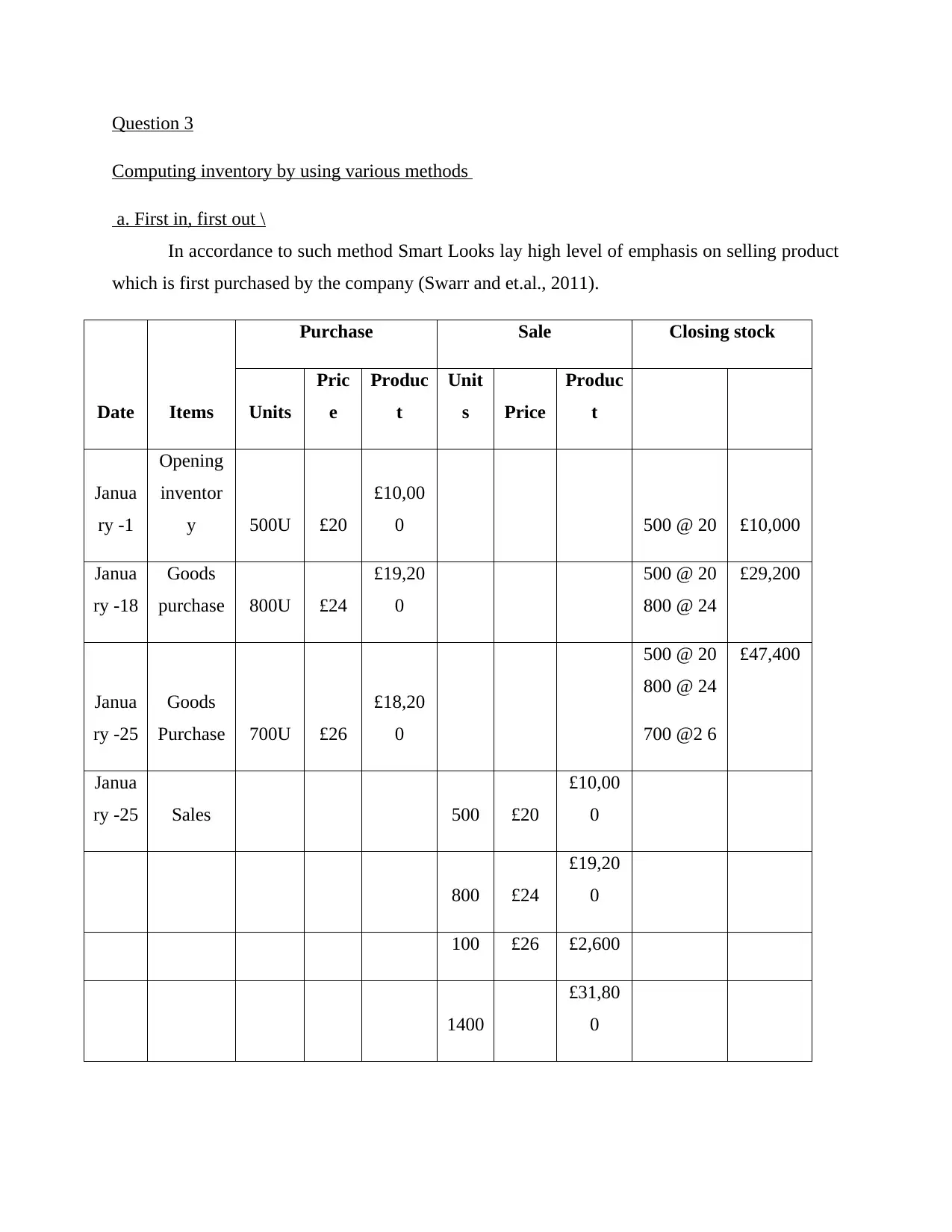
Question 3
Computing inventory by using various methods
a. First in, first out \
In accordance to such method Smart Looks lay high level of emphasis on selling product
which is first purchased by the company (Swarr and et.al., 2011).
Date Items
Purchase Sale Closing stock
Units
Pric
e
Produc
t
Unit
s Price
Produc
t
Janua
ry -1
Opening
inventor
y 500U £20
£10,00
0 500 @ 20 £10,000
Janua
ry -18
Goods
purchase 800U £24
£19,20
0
500 @ 20
800 @ 24
£29,200
Janua
ry -25
Goods
Purchase 700U £26
£18,20
0
500 @ 20
800 @ 24
700 @2 6
£47,400
Janua
ry -25 Sales 500 £20
£10,00
0
800 £24
£19,20
0
100 £26 £2,600
1400
£31,80
0
Computing inventory by using various methods
a. First in, first out \
In accordance to such method Smart Looks lay high level of emphasis on selling product
which is first purchased by the company (Swarr and et.al., 2011).
Date Items
Purchase Sale Closing stock
Units
Pric
e
Produc
t
Unit
s Price
Produc
t
Janua
ry -1
Opening
inventor
y 500U £20
£10,00
0 500 @ 20 £10,000
Janua
ry -18
Goods
purchase 800U £24
£19,20
0
500 @ 20
800 @ 24
£29,200
Janua
ry -25
Goods
Purchase 700U £26
£18,20
0
500 @ 20
800 @ 24
700 @2 6
£47,400
Janua
ry -25 Sales 500 £20
£10,00
0
800 £24
£19,20
0
100 £26 £2,600
1400
£31,80
0
⊘ This is a preview!⊘
Do you want full access?
Subscribe today to unlock all pages.

Trusted by 1+ million students worldwide
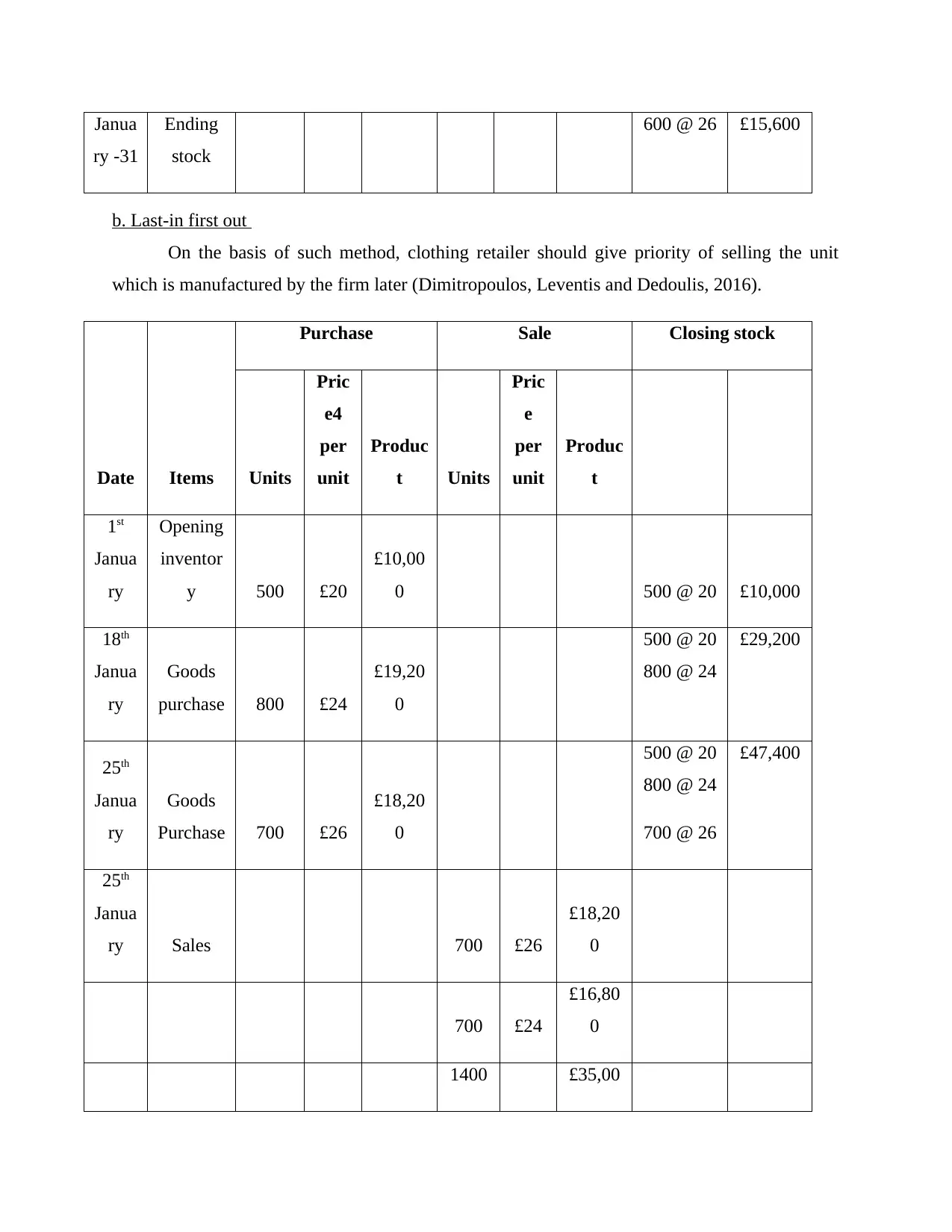
Janua
ry -31
Ending
stock
600 @ 26 £15,600
b. Last-in first out
On the basis of such method, clothing retailer should give priority of selling the unit
which is manufactured by the firm later (Dimitropoulos, Leventis and Dedoulis, 2016).
Date Items
Purchase Sale Closing stock
Units
Pric
e4
per
unit
Produc
t Units
Pric
e
per
unit
Produc
t
1st
Janua
ry
Opening
inventor
y 500 £20
£10,00
0 500 @ 20 £10,000
18th
Janua
ry
Goods
purchase 800 £24
£19,20
0
500 @ 20
800 @ 24
£29,200
25th
Janua
ry
Goods
Purchase 700 £26
£18,20
0
500 @ 20
800 @ 24
700 @ 26
£47,400
25th
Janua
ry Sales 700 £26
£18,20
0
700 £24
£16,80
0
1400 £35,00
ry -31
Ending
stock
600 @ 26 £15,600
b. Last-in first out
On the basis of such method, clothing retailer should give priority of selling the unit
which is manufactured by the firm later (Dimitropoulos, Leventis and Dedoulis, 2016).
Date Items
Purchase Sale Closing stock
Units
Pric
e4
per
unit
Produc
t Units
Pric
e
per
unit
Produc
t
1st
Janua
ry
Opening
inventor
y 500 £20
£10,00
0 500 @ 20 £10,000
18th
Janua
ry
Goods
purchase 800 £24
£19,20
0
500 @ 20
800 @ 24
£29,200
25th
Janua
ry
Goods
Purchase 700 £26
£18,20
0
500 @ 20
800 @ 24
700 @ 26
£47,400
25th
Janua
ry Sales 700 £26
£18,20
0
700 £24
£16,80
0
1400 £35,00
Paraphrase This Document
Need a fresh take? Get an instant paraphrase of this document with our AI Paraphraser
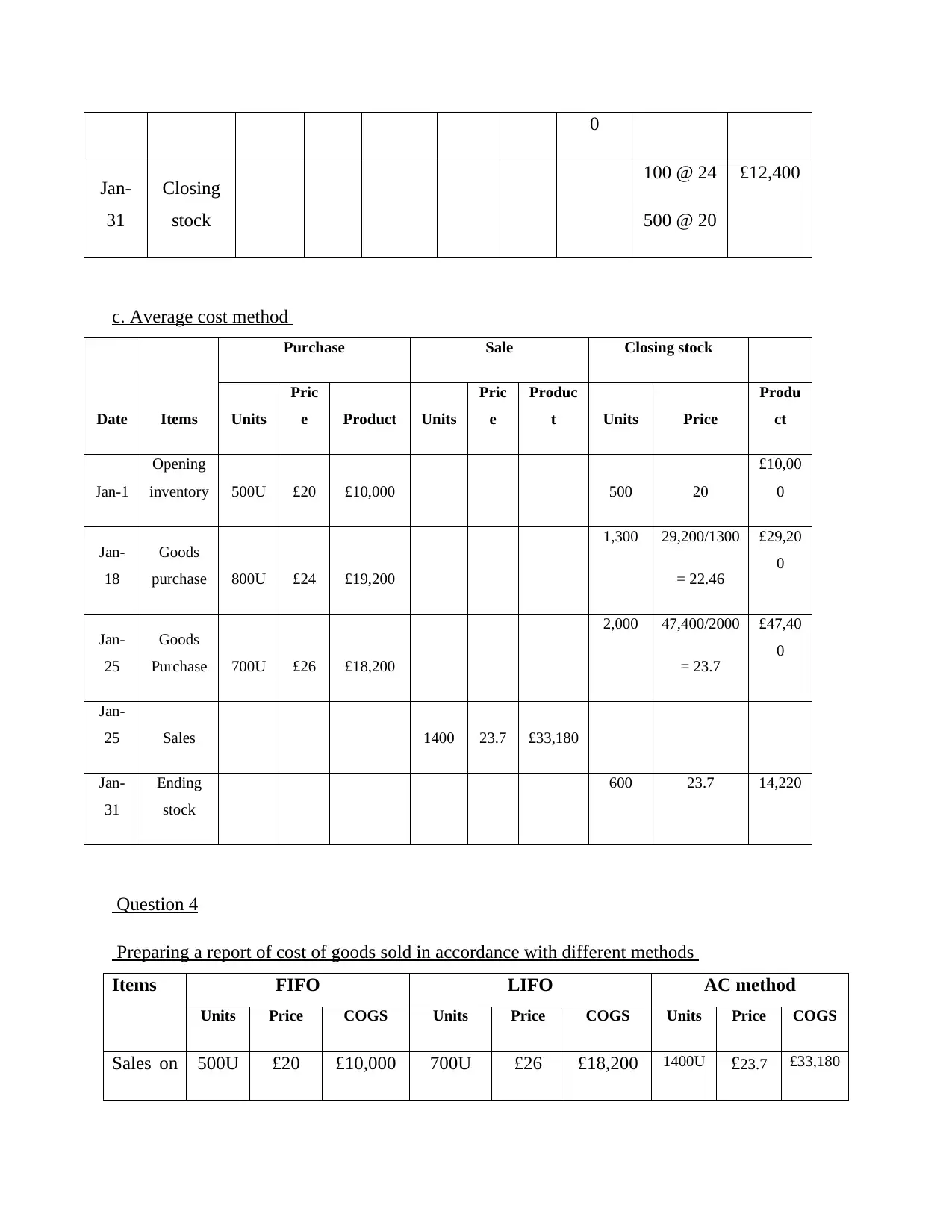
0
Jan-
31
Closing
stock
100 @ 24
500 @ 20
£12,400
c. Average cost method
Date Items
Purchase Sale Closing stock
Units
Pric
e Product Units
Pric
e
Produc
t Units Price
Produ
ct
Jan-1
Opening
inventory 500U £20 £10,000 500 20
£10,00
0
Jan-
18
Goods
purchase 800U £24 £19,200
1,300 29,200/1300
= 22.46
£29,20
0
Jan-
25
Goods
Purchase 700U £26 £18,200
2,000 47,400/2000
= 23.7
£47,40
0
Jan-
25 Sales 1400 23.7 £33,180
Jan-
31
Ending
stock
600 23.7 14,220
Question 4
Preparing a report of cost of goods sold in accordance with different methods
Items FIFO LIFO AC method
Units Price COGS Units Price COGS Units Price COGS
Sales on 500U £20 £10,000 700U £26 £18,200 1400U £23.7 £33,180
Jan-
31
Closing
stock
100 @ 24
500 @ 20
£12,400
c. Average cost method
Date Items
Purchase Sale Closing stock
Units
Pric
e Product Units
Pric
e
Produc
t Units Price
Produ
ct
Jan-1
Opening
inventory 500U £20 £10,000 500 20
£10,00
0
Jan-
18
Goods
purchase 800U £24 £19,200
1,300 29,200/1300
= 22.46
£29,20
0
Jan-
25
Goods
Purchase 700U £26 £18,200
2,000 47,400/2000
= 23.7
£47,40
0
Jan-
25 Sales 1400 23.7 £33,180
Jan-
31
Ending
stock
600 23.7 14,220
Question 4
Preparing a report of cost of goods sold in accordance with different methods
Items FIFO LIFO AC method
Units Price COGS Units Price COGS Units Price COGS
Sales on 500U £20 £10,000 700U £26 £18,200 1400U £23.7 £33,180
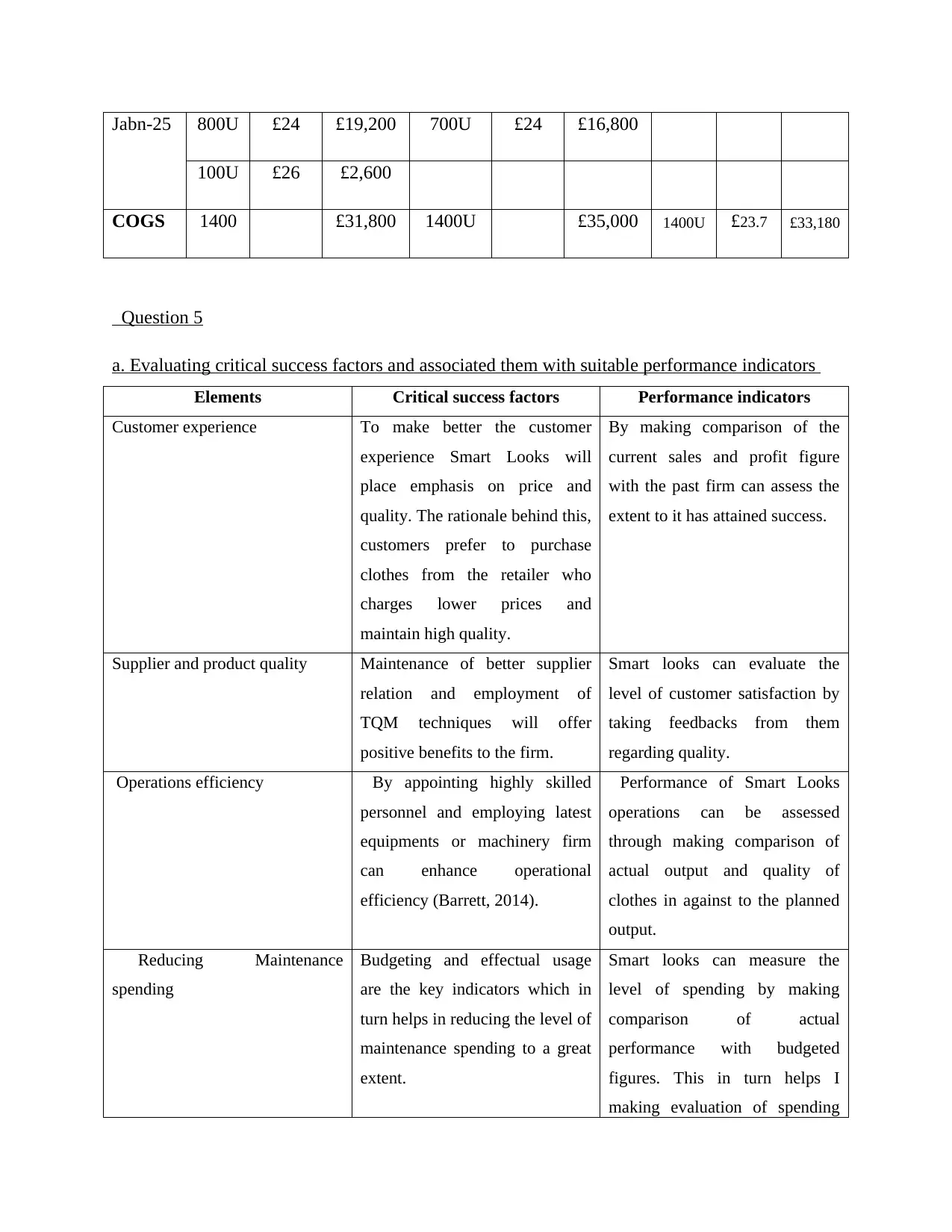
Jabn-25 800U £24 £19,200 700U £24 £16,800
100U £26 £2,600
COGS 1400 £31,800 1400U £35,000 1400U £23.7 £33,180
Question 5
a. Evaluating critical success factors and associated them with suitable performance indicators
Elements Critical success factors Performance indicators
Customer experience To make better the customer
experience Smart Looks will
place emphasis on price and
quality. The rationale behind this,
customers prefer to purchase
clothes from the retailer who
charges lower prices and
maintain high quality.
By making comparison of the
current sales and profit figure
with the past firm can assess the
extent to it has attained success.
Supplier and product quality Maintenance of better supplier
relation and employment of
TQM techniques will offer
positive benefits to the firm.
Smart looks can evaluate the
level of customer satisfaction by
taking feedbacks from them
regarding quality.
Operations efficiency By appointing highly skilled
personnel and employing latest
equipments or machinery firm
can enhance operational
efficiency (Barrett, 2014).
Performance of Smart Looks
operations can be assessed
through making comparison of
actual output and quality of
clothes in against to the planned
output.
Reducing Maintenance
spending
Budgeting and effectual usage
are the key indicators which in
turn helps in reducing the level of
maintenance spending to a great
extent.
Smart looks can measure the
level of spending by making
comparison of actual
performance with budgeted
figures. This in turn helps I
making evaluation of spending
100U £26 £2,600
COGS 1400 £31,800 1400U £35,000 1400U £23.7 £33,180
Question 5
a. Evaluating critical success factors and associated them with suitable performance indicators
Elements Critical success factors Performance indicators
Customer experience To make better the customer
experience Smart Looks will
place emphasis on price and
quality. The rationale behind this,
customers prefer to purchase
clothes from the retailer who
charges lower prices and
maintain high quality.
By making comparison of the
current sales and profit figure
with the past firm can assess the
extent to it has attained success.
Supplier and product quality Maintenance of better supplier
relation and employment of
TQM techniques will offer
positive benefits to the firm.
Smart looks can evaluate the
level of customer satisfaction by
taking feedbacks from them
regarding quality.
Operations efficiency By appointing highly skilled
personnel and employing latest
equipments or machinery firm
can enhance operational
efficiency (Barrett, 2014).
Performance of Smart Looks
operations can be assessed
through making comparison of
actual output and quality of
clothes in against to the planned
output.
Reducing Maintenance
spending
Budgeting and effectual usage
are the key indicators which in
turn helps in reducing the level of
maintenance spending to a great
extent.
Smart looks can measure the
level of spending by making
comparison of actual
performance with budgeted
figures. This in turn helps I
making evaluation of spending
⊘ This is a preview!⊘
Do you want full access?
Subscribe today to unlock all pages.

Trusted by 1+ million students worldwide
1 out of 24
Related Documents
Your All-in-One AI-Powered Toolkit for Academic Success.
+13062052269
info@desklib.com
Available 24*7 on WhatsApp / Email
![[object Object]](/_next/static/media/star-bottom.7253800d.svg)
Unlock your academic potential
Copyright © 2020–2025 A2Z Services. All Rights Reserved. Developed and managed by ZUCOL.





